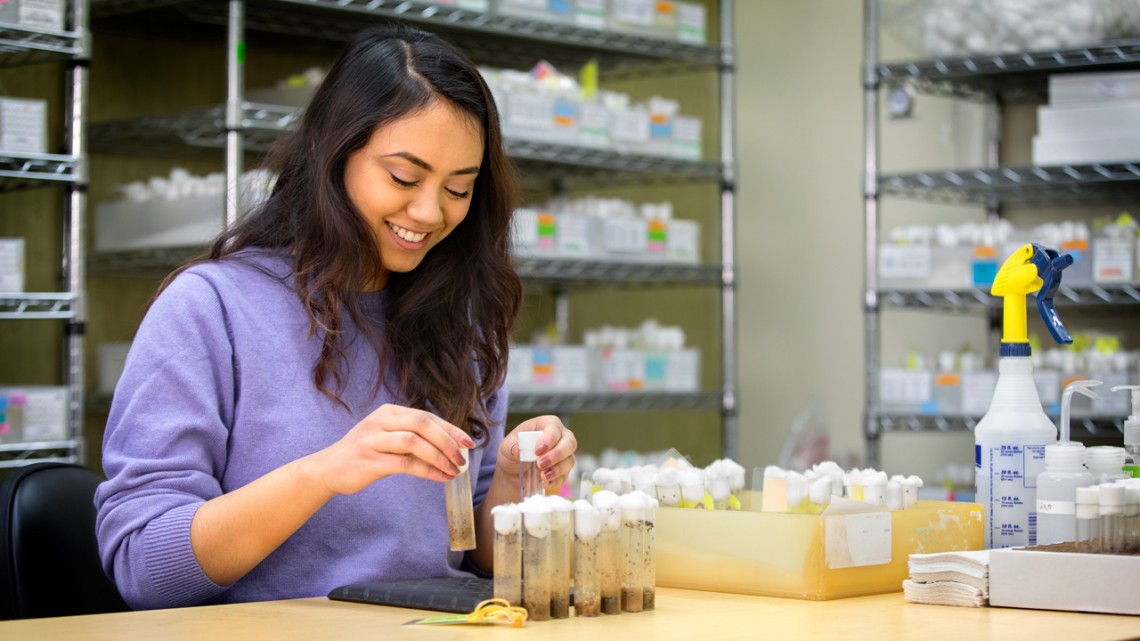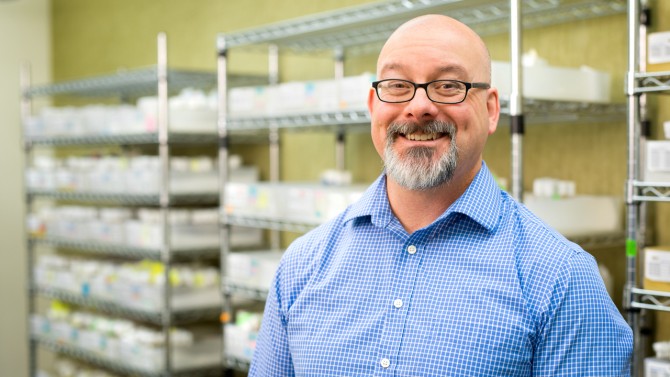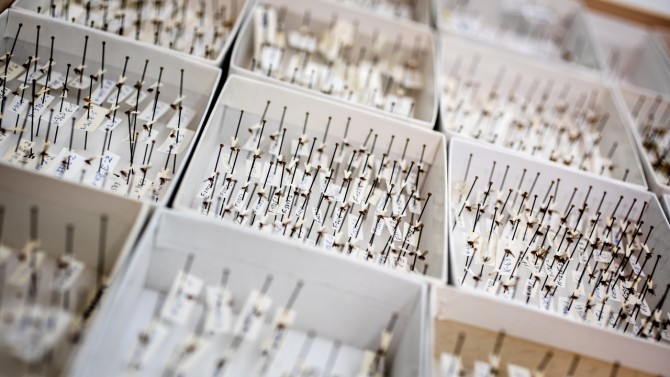
Lidane Noronha, manager of the National Drosophila Species Stock Center, oversees 3,000 vials containing a total of 300 species of fruit flies in Comstock Hall.
‘Lab rats of molecular biology’ find home on campus
By Krishna Ramanujan
Fruit flies in your kitchen are an annoyance, but fruit flies in a research lab play a vital role in advancing our understanding of biology.
Some scientists refer to the fruit fly species Drosophila melanogaster as the lab rat of molecular biology. Since the lowly fruit fly shares a great deal of biology with higher animals and even humans, Drosophila studies have led to advancements in such fields as basic biology, developmental biology and genetics across vertebrates.
“A lot of what we know about human and mammalian development has been derived from studies on Drosophila,” said Patrick O’Grady, professor of entomology and director of the National Drosophila Species Stock Center.
The center moved to campus from the University of California, San Diego, in October after O’Grady, previously at UC Berkeley, joined Cornell’s faculty last July. For $40, any researcher can order a vial of fruit flies and a separate vial of eggs and larvae from the repository, which is one of two fruit fly stock centers in the country.
The center houses 300 different species of Drosophila. A few of the species were collected in the 1950s and have been maintained since then. Several species are no longer found in the wild.
Drosophila science
The study of biology often requires model organisms, nonhuman species that shed light on biological processes that are shared across organisms. Model organisms – such as Arabidopsis plants, mice and Drosophila – have metabolic and developmental pathways and genetics that are conserved across species over the course of evolution.
“If you want to study development, an organism that goes from eggs to fully mature adult in seven days is a lot easier to work with than one that takes 14 years,” O’Grady said.
Similarly, understanding of neurobiology has benefited from studying Drosophila brains. And, many genes exist in fruit flies in exactly the same order as they exist in humans. Small Drosophila genomes are relatively easy to sequence and have been used to improve annotation of the human genome by shedding light on how homologous fruit fly genes are structured and work, and by providing opportunities for computational geneticists to fine-tune algorithms for sequencing and analyzing genomes.
Ecologists and entomologists are interested in the relationships between insects and plants, and how insects pick their hosts. An international team of researchers, which included Andrew Clark, the Jacob Gould Schurman Professor of Population Genetics in the Department of Molecular Biology and Genetics, ordered samples of D. pachea and identified mutations in a gene that allows this fruit fly to feed exclusively on a single plant host, the senita cactus. D. pachea has made adaptations that allow it to tolerate the plant’s defenses, including poisonous sterols.
And Mariana Wolfner, the Goldwin Smith Professor of Molecular Biology and Genetics, has done extensive work with Drosophila, identifying proteins transferred from males to females during mating and how those molecules affect the female’s post-mating physiology and behavior and using CT scans to better understand the internal architecture of female fruit flies.
Expanding insect collection
Along with the stock center’s living collection, O’Grady brought with him thousands of pinned specimens that have been added to the Cornell University Insect Collection. Some of these came with the stock center and others belonged to O’Grady’s private collection. The insect museum used to house 12 Drosophila species in three cabinet drawers; now there are 700 species in 55 drawers.
“This is one of the largest Drosophila collections in the world at this point,” O’Grady said, adding that it is common for experts on campus to expand museum collections. For example, Cornell has world-renowned collections of Sciomyzidae, marsh flies that attack snails, thanks to the late Cornell entomologist Clifford Berg, and of horse and deer flies, from the late Cornell international authority on blood-sucking flies, Laverne Pechuman.
O’Grady specializes in Hawaiian Drosophila, which began as a single type of fruit fly 25 million years ago and have evolved to 1,000 species today. He has identified some 80 new species and is interested in how biodiversity forms.
“I am interested in knowing how they are related to one another,” he said. He uses DNA to build a family tree, and then investigates how long species’ have been in an area, how fast they diversified, and what traits helped them diversify.
So far, 700 to 800 species have been described, with many related species pinned in the University of Hawaii at Manoa’s insect collection awaiting description. O’Grady looks forward to future expeditions to Hawaii, where he hopes to identify even more Drosophila, he said.
Media Contact
Get Cornell news delivered right to your inbox.
Subscribe


